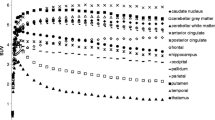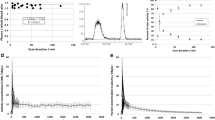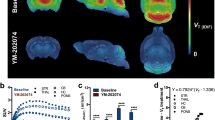Abstract
Purpose
[18F]Fluoroethoxybenzovesamicol ([18F]FEOBV) is a radioligand for the vesicular acetylcholine transporter (VAChT), a marker of the cholinergic system. We evaluated the quantification of [18F]FEOBV in rats in control conditions and after partial saturation of VAChT using plasma and reference tissue input models and test-retest reliability.
Procedure
Ninety-minute dynamic [18F]FEOBV PET scans with arterial blood sampling were performed in control rats and rats pretreated with 10 μg/kg FEOBV. Kinetic analyses were performed using one- (1TCM) and two-tissue compartmental models (2TCM), Logan and Patlak graphical analyses with metabolite-corrected plasma input, reference tissue Patlak with cerebellum as reference tissue, standard uptake value (SUV) and SUV ratio (SUVR) using 60- or 90-min acquisition. To assess test-retest reliability, two dynamic [18F]FEOBV scans were performed 1 week apart.
Results
The 1TCM did not fit the data. Time-activity curves were more reliably estimated by the irreversible than the reversible 2TCM for 60 and 90 min as the influx rate Ki showed a lower coefficient of variation (COV, 14–24 %) than the volume of distribution VT (16–108 %). Patlak graphical analysis showed a good fit to the data for both acquisition times with a COV (12–27 %) comparable to the irreversible 2TCM. For 60 min, Logan analysis performed comparably to both irreversible models (COV 14–32 %) but showed lower sensitivity to VAChT saturation. Partial saturation of VAChT did not affect model selection when using plasma input. However, poor correlations were found between irreversible 2TCM and SUV and SUVR in partially saturated VAChT states. Test-retest reliability and intraclass correlation for SUV were good.
Conclusion
[18F]FEOBV is best modeled using the irreversible 2TCM or Patlak graphical analysis. SUV should only be used if blood sampling is not possible.



Similar content being viewed by others
References
Geula C, Mesulam MM (1996) Systematic regional variations in the loss of cortical cholinergic fibers in Alzheimer’s disease. Cereb Cortex 6:165–177
Kuhl DE, Minoshima S, Fessler JA, Frey KA, Foster NL, Ficaro EP, Wieland DM, Koeppe RA (1996) In vivo mapping of cholinergic terminals in normal aging, Alzheimer’s disease, and Parkinson’s disease. Ann Neurol 40:399–410
Whitehouse PJ, Hedreen JC, White CL, Price DL (1983) Basal forebrain neurons in the dementia of Parkinson disease. Ann Neurol 13:243–248
Gilmor ML, Erickson JD, Varoqui H, Hersh LB, Bennett DA, Cochran EJ, Mufson EJ, Levey AI (1999) Preservation of nucleus basalis neurons containing choline acetyltransferase and the vesicular acetylcholine transporter in the elderly with mild cognitive impairment and early Alzheimer’s disease. J Comp Neurol 411:693–704
Mulholland GK, Wieland DM, Kilbourn MR, Frey KA, Sherman PS, Carey JE, Kuhl DE (1998) [18F]fluoroethoxy-benzovesamicol, a PET radiotracer for the vesicular acetylcholine transporter and cholinergic synapses. Synapse 30:263–274
Kilbourn MR, Hockley B, Lee L, Sherman P, Quesada C, Frey KA, Koeppe RA (2009) Positron emission tomography imaging of (2R,3R)-5-[18F]fluoroethoxybenzovesamicol in rat and monkey brain: a radioligand for the vesicular acetylcholine transporter. Nucl Med Biol 36:489–493
Petrou M, Frey KA, Kilbourn MR, Scott PJ, Raffel DM, Bohnen NI, Müller ML, Albin RL, Koeppe RA (2014) In vivo imaging of human cholinergic nerve terminals with (−)-5-18F-Fluoroethoxybenzovesamicol: biodistribution, Dosimetry, and tracer kinetic analyses. J Nucl Med 55:396–404
Parent M, Bedard M-AA, Aliaga A et al (2012) PET imaging of cholinergic deficits in rats using [18F]fluoroethoxybenzovesamicol ([18F]FEOBV). Neuroimage 62:555–561
Alves IL, Vállez García D, Parente A et al (2017) Pharmacokinetic modeling of [11C]flumazenil kinetics in the rat brain. EJNMMI Res 7:17
Willson JE, Brown DE, Timmens EK (1965) A toxicologic study of dimethyl sulfoxide. Toxicol Appl Pharmacol 7:104–112
Mulholland GK, Jung Y-W, Wieland DM et al (1993) Synthesis of [18F]Fluoroethoxy-benzovesamicol, a radiotracer for cholinergic neurons. J Label Compd Radiopharm 33:583–591
Vállez Garcia D, Casteels C, Schwarz AJ et al (2015) A standardized method for the construction of tracer specific PET and SPECT rat brain templates: validation and implementation of a toolbox. PLoS One 10:e0122363
Logan J, Fowler JS, Volkow ND, Wolf AP, Dewey SL, Schlyer DJ, MacGregor R, Hitzemann R, Bendriem B, Gatley SJ (1990) Graphical analysis of reversible radioligand binding from time-activity measurements applied to [N-11C-methyl]-(-)-cocaine PET studies in human subjects. J Cereb Blood Flow Metab 10:740–747
Patlak CS, Blasberg RG, Fenstermacher JD (1983) Graphical evaluation of blood-to-brain transfer constants from multiple-time uptake data. J Cereb Blood Flow Metab 3:1–7
Shrout PE, Fleiss JL (1979) Intraclass correlations: uses in assessing rater reliability. Psychol Bull 86:420–428
Zweig MH, Campbell G (1993) Receiver-operating characteristic (ROC) plots: a fundamental evaluation tool in clinical medicine. Clin Chem 39(4):561–577
Albin RL, Bohnen NI, Muller MLTM, Dauer WT, Sarter M, Frey KA, Koeppe RA (2018) Regional vesicular acetylcholine transporter distribution in human brain: a [18F]fluoroethoxybenzovesamicol positron emission tomography study. J Comp Neurol 526:2884–2897
Herfert K, Mannheim JG, Kuebler L et al (2019) Quantitative rodent brain receptor imaging. Mol Imaging Biol:1–22
Patlak CS, Blasberg RG (1985) Graphical evaluation of blood-to-brain transfer constants from multiple-time uptake data. Generalizations J Cereb Blood Flow Metab 5:584–590
Shichino T, Murakawa M, Adachi T, Nakao S, Shinomura T, Kurata J, Mori K (1997) Effects of isoflurane on in vivo release of acetylcholine in the rat cerebral cortex and striatum. Acta Anaesthesiol Scand 41:1335–1340
Whittington RA, Virág L (2010) The differential effects of equipotent doses of isoflurane and desflurane on hippocampal acetylcholine levels in young and aged rats. Neurosci Lett 471:166–170
Su D, Zhao Y, Wang B et al (2011) Isoflurane-induced spatial memory impairment in mice is prevented by the acetylcholinesterase inhibitor donepezil. PLoS One 6:e27632
Ni C, Tan G, Luo A, Qian M, Tang Y, Zhou Y, Wang J, Li M, Zhang Y, Jia D, Wu C, Guo X (2013) Melatonin premedication attenuates isoflurane anesthesia-induced β-amyloid generation and cholinergic dysfunction in the hippocampus of aged rats. Int J Neurosci 123:213–220
Acknowledgments
We thank Paula Kopschina Feltes and Rolf Zijlma for their help during the setup of the metabolite analysis and David Vállez Garcia for advice on kinetic modeling.
Funding
Anna Schildt received financial support from the Djavad Mowafaghian Centre for Brain Health.
Author information
Authors and Affiliations
Corresponding author
Ethics declarations
The study protocol was approved by the Institutional Animal Care and Use Committee of the University of Groningen. All experiments were performed by licensed investigators in compliance with the Law on Animal Experiments of The Netherlands.
Conflict of Interest
The authors declare that they have no conflict of interest.
Additional information
Publisher’s Note
Springer Nature remains neutral with regard to jurisdictional claims in published maps and institutional affiliations.
Electronic Supplementary Material
ESM 1
(PDF 245 kb)
Rights and permissions
About this article
Cite this article
Schildt, A., de Vries, E.F., Willemsen, A.T. et al. Modeling of [18F]FEOBV Pharmacokinetics in Rat Brain. Mol Imaging Biol 22, 931–939 (2020). https://doi.org/10.1007/s11307-019-01466-8
Published:
Issue Date:
DOI: https://doi.org/10.1007/s11307-019-01466-8




